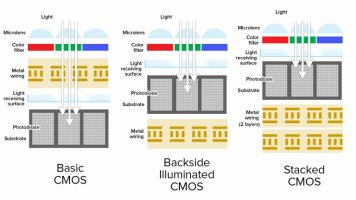Not sure if changing the order of the layers really makes it much more expensive. Would it really cost more to print the electrical circuits at the back of the photodiodes?
View attachment 206095
Source: PC Mag
BSI etches the substrate wafer from both sides meaning a thinner, more fragile wafer. That likely leads to greater QC loss, which disproportionately affects larger sensors (with FSI, and made even worse with BSI).
Stacking requires a second die fused to the photodiode die. However, putting the bulk of the circuitry on a second die means the photodiode die is simpler and can be fabricated with larger-scale (older, cheaper) processes.
I have no idea how that breaks down in actual numbers. Certainly when they were new tech, BSI sensors cost more. But BSI enabled smaller pixel pitch, driven mainly by the smartphone and industrial sensors that are a much larger market than ILCs, and no doubt major efforts were made to reduce fab costs.
Either way, for high-end items like ILCs (all of them, even entry-level), the cost of goods is not the most important factor in setting price. It’s much more about market size and the required margin to drive ROI on the R&D.
An example from my own industry, the first Vertex drug to treat cystic fibrosis costs ~$475 per pill. One Tylenol caplet costs about the same to manufacture as one Kalydeco tablet, so that $475 for one pill would buy you >6,000 Tylenol caplets.

